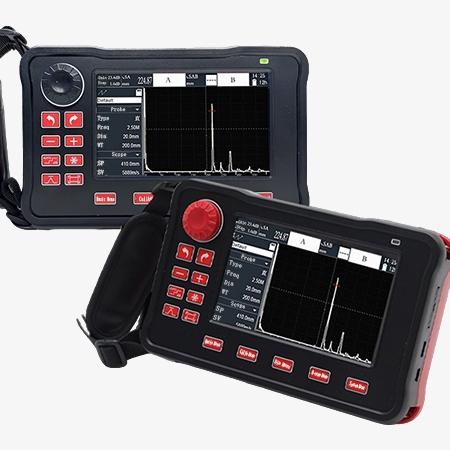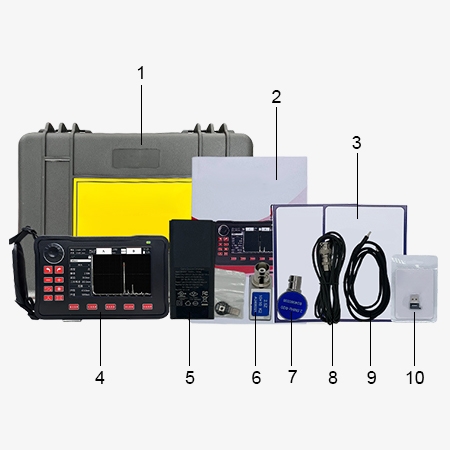The ultrasonic crack detector boasts high sensitivity, strong penetration, and accurate damage detection. It also boasts fast inspection speeds, making it suitable for both laboratory and on-site inspections.

Intelligent Flaw Detection, Efficiency First
- The ultrasonic crack detector offers high-precision quantification and positioning capabilities, with a small near-field blind spot, meeting both close- and long-range flaw detection needs. It's also suitable for small-diameter and thin-walled pipe inspections. It also supports one-click auto-calibration, automatically testing probe parameters and material sound velocity for easy operation.
- The ultrasonic flaw detection equipment automatically displays multiple data points, including depth, level, and distance, for flaw echo location. Three scales can be freely switched. It also features automatic gain and echo envelope, and can automatically record and dynamically replay the flaw detection process for an unlimited time, significantly improving flaw detection efficiency.
- For data storage and standard applications, the XUT920 ultrasonic flaw detector machine features 500 independent flaw detection channels (expandable) to store any industry flaw detection standard, eliminating the need to carry test blocks. It can also store and replay 500 A-scan waveforms and data, and automatically generate and compensate DAC and AVG curves.

Designed for Demanding Field Operations
- The ultrasonic crack detection machine supports B-scan functionality, clearly displaying the longitudinal cross-section of flaws, helping workers more intuitively identify flaw morphology. The instrument system can be upgraded via (wireless) communication software, and the PC communication software's soft keyboard allows for computer-controlled flaw detection, offering exceptional expandability and remote control convenience.
- The ultrasonic crack detection equipment features an IP65-compliant aluminum-magnesium alloy housing, making it durable, waterproof, dustproof, and highly resistant to interference. It features a 260,000-color, high-brightness display with adjustable brightness, adapting to varying lighting conditions. It also supports computer communication and can export flaw detection reports in Word format.
- The digital ultrasonic flaw detector is equipped with a high-performance, safe, and environmentally friendly lithium battery, offering 8-10 hours of continuous operation (technical specifications), meeting the needs of extended field operations. The instrument features an IP65-compliant aluminum-magnesium alloy housing, ensuring waterproof, dustproof, and highly resistant to interference. Weighing only 1.0 kg, it is lightweight and portable.
Application
The flaw detector plays a pivotal role across multiple industries. In the metal industry, it scans high-strength steel components for heavy machinery, spotting internal flaws in metal billets that could weaken the final product. For steel structures like large bridges, it precisely detects invisible cracks in welds, ensuring long-term structural integrity. In chemical equipment, it checks for material degradation in reactors and pipelines, preventing leaks. In aerospace, it inspects aircraft parts to avoid catastrophic failures. It also accurately gauges weld defects in shipbuilding and detects fatigue in oil drill pipes, minimizing risks in these critical sectors.

Metal Industry

Steel Structures

Chemical Equipment

Aerospace
| Model | ultrasonic-flaw-detector |
| Bandwidth | 0.1MHz~20MHz |
| Gain | 120dB, step 0.1dB,0.6dB, 1dB, 2dB, 6dB |
| Filter | broadband, 1M, 1.25M, 2.5M, 5M, 10M, 15M, 1M-5M |
| Sampling Rate | hardware sampling rate 100MSPS, equivalent sampling rate 400MSPS |
| Detection Mode | full wave, positive half wave, negative half wave, radio frequency, envelope |
| Detection Range | 20 meters (carbon steel for longitudinal wave), step 100mm, 10mm, 0.1mm |
| Sound Velocity Range | 250~16000m/s |
| Launch Damping | djustable |
| Pulse Mode | sharp pulse, single square wave, double square wave |
| Pulse Voltage | 25V~300V, 25V step |
| Pulse Width | 0ns~500ns continuously adjustable, 5ns step |
| Pulse Frequency | automatic or manual, 0-1250Hz |
| Probe Channel | 200 groups, support new, preview, delete, rename, overwrite, restore, and other operations |
| Gate Alarm | Gate A and B report wave loss/injection |
| Gate Mode | independent gate A, gate B |
| Measurement Mode | peak, front edge, J front edge |
| Quantitative Mode | DAC curve, AVG (DGS) curve |
| Scoring Standards | AWS D1.1/D1.5, NB/T47013GB/T29712GB/T11345 |
| Save Content | single frame, multi-frame recording (<500 frames), screen capture |
| Auxiliary Functions | automatic gain, wave memory, waveform freeze, channel management, gate alarm, gate expansion, automatic gate, full screen touch, virtual keyboard, quick screenshot, channel import/export |
| Display | HD 5.0 inch 800×480 LCD, IPS_LCD |
| Probe Interface | dual LEMO-00 C5 |
| Output Interface | Type-C1, MINI USB |
| Input Interface | Type-C2 |
| Data Storage | 8GB SD card |
| Charger | 30W PD fast charge, standard Type-C interface (100~240V,50~60Hz) |
| Size | 183mm×113mm×45mm |
| Weight | 700g, contains a battery, and does not contain a rubber sleeve |
| Units | metric, imperial |
| Battery | 7.4V 8000mAh lithium battery, 12 hours of endurance |
| Working Temperature | -10℃~55℃ |
| Resolution | 30dB (metering performance requirement: ≥26dB) |
| Dynamic Range | 35dB (metering performance requirement: ≥26dB) |
| Sensitivity Margin | 50dB (metering performance requirement: ≥42dB) |
| Vertical Linearity | 1.20% (metering performance requirement: ≤6%) |
| Horizontal Linearity | 0.15% (measuring performance requirement: ≤2%) |
Packaged List

Q1: What is a flaw detector?
A1: A flaw detector is a device used to identify defects or imperfections in materials, structures, or components. It employs various non-destructive testing (NDT) techniques, such as ultrasound, eddy current, X-rays, or magnetic particle testing, to detect cracks, voids, or other irregularities. These methods help assess the internal and surface condition of materials, ensuring their quality and safety. Flaw detectors are widely used in industries like manufacturing, aerospace, and construction to improve product reliability and lifespan.
Q2: How does a flaw detector work?
A2: A flaw detector works by using non-destructive testing (NDT) techniques to inspect materials for internal or surface defects. For example, in ultrasonic testing, the device emits high-frequency sound waves that travel through the material. If there’s a flaw, the waves will bounce back, and the detector measures the time it takes for the sound to return, indicating the size and location of the defect. In other methods, like eddy current testing, electromagnetic fields are used to detect irregularities. The data collected helps technicians identify weaknesses without damaging the material.
Q3: What are the limitations of UT?
A3: Ultrasonic Testing (UT) has several limitations. It requires good surface contact, so rough, corroded, or coated surfaces can affect the accuracy of results. UT may also struggle with very thin or extremely thick materials, as sound waves might not penetrate well enough. The effectiveness of UT depends heavily on the skill and experience of the technician, as improper interpretation can lead to false positives or missed defects. It’s also challenging for UT to detect flaws in complex geometries, like pipes with bends or hard-to-reach areas. Additionally, the technique is angle-sensitive, meaning incorrect alignment of the transducer can cause missed defects, particularly in irregularly shaped parts. Lastly, materials like composites or highly attenuating metals may not be suitable for UT, as sound waves may not propagate effectively through them.
Tips: Common Mistakes in Using Ultrasonic Flaw Detectors
Common operating errors with ultrasonic flaw detectors primarily include failing to calibrate the probe and instrument according to specifications, resulting in baseline deviation; neglecting workpiece surface cleanliness and couplant selection, which can affect sound wave transmission; over-reliance on preset parameters without adjusting sensitivity based on workpiece material and thickness; mistaking flaw waves for noise and making judgments without fully scanning. These errors can directly reduce detection accuracy and even lead to misjudgments.
Thank you for buying industrial test and measurement equipment on SISCO.com, all products sold by SISCO and the partner cover a 12 months warranty, effective from the date of receiving the products.
What is covered?
SISCO is responsible for providing free spare parts, and free technical support to assist the customer to repair the defective products until the problem is solved.
What is not covered?
- Product purchased from anyone other than a SISCO store or a SISCO authorized reseller.
- Expendable parts.
- Routine cleaning or normal cosmetic and mechanical wear.
- Damage from misuse, abuse or neglect.
- Damage from use of parts other than SISCO approved.
- Damage from use outside the product’s usage or storage parameters.
- Damage from use of parts not sold by SISCO.
- Damage from modification or incorporation into other products.
- Damage from repair or replacement of warranted parts by a service provider other than a SISCO authorized service provider.
- Damage caused by the application environment not meeting the product usage requirements and the failure to perform preventive maintenance.

